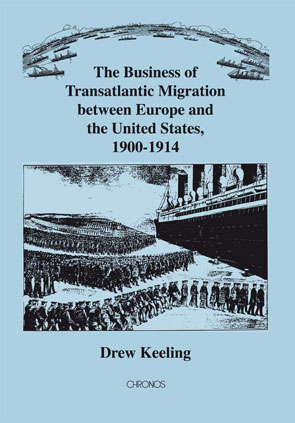«In conclusion, this is an excellent study of the economic, social and political dimension of transatlantic transport. Fittingly, Keeling writes very efficiently about a history of efficiency. He successfully orders the potentially overwhelming source material. […] One cannot but hope that Keeling’s excellent trans-disciplinary study, which skilfully combines diligent research with accessible prose, will encourage future research on these areas.»
Nicole K. Konopka, German History
- Kurztext
- Autor/in
- Einblick
- In den Medien
- Downloads
This is the first systematic examination of the business of mass migration travel across the North Atlantic during the period of unprecedented globalization prior to World War I. It explicates the reinforcing interests and actions of the oceanic shipping lines, their migrant customers, and contemporary government authorities, in coping with the substantial risks of mass physical relocation, particularly those due to cyclical economic recessions, and in keeping migration safe, smooth and largely self-regulated. In a comprehensive analysis backed up by extensive and consistent statistics, it details the motives and mechanisms by which these eleven million Europe-born migrants made nineteen million ocean crossings on eighteen thousand voyages of several hundred large steamships, generating hundreds of millions of dollars in revenues for these steamship lines during the pivotal peak years of early twentieth century migration between Europe and America, and it describes how this long-lived long-distance travel business operated as the crucial common denominator of the greatest and most ethnically diverse mass transoceanic relocation ever. For more information see www.business-of-migration.com.
Inhalt
Introduction
1. Transportation Revolution and European Exodus
2. The Economics of Migrant Travel
3. Competition, Conferences and Combinations, 1900-03
4. The North Atlantic Fare War of 1904
5. More Control at the Gates, 1902-07
6. Coping with the Cyclical Slump of 1907-08
7. Comfort and Safety at Sea: Repeat migration, closed berths, and “boats for all,” 1909-14
8. Conclusions
Epilogue
Appendix
Suggestions for Further Reading
Bibliography
1. Transportation Revolution and European Exodus
2. The Economics of Migrant Travel
3. Competition, Conferences and Combinations, 1900-03
4. The North Atlantic Fare War of 1904
5. More Control at the Gates, 1902-07
6. Coping with the Cyclical Slump of 1907-08
7. Comfort and Safety at Sea: Repeat migration, closed berths, and “boats for all,” 1909-14
8. Conclusions
Epilogue
Appendix
Suggestions for Further Reading
Bibliography
Pressestimmen
«Anyone working on international migration during this period will need to take Keeling''s book into account.»
Raymond L. Cohn, International Journal of Maritime History
«The book provides a wealth of statistical and narrative information that will be of exceptional utility to future scholars. Keeling's encyclopedic knowledge of sources and his ability to synthesize them are on brilliant display. […] Without question, this topic is an important and relatively neglected aspect of early twentieth century migration, and Keeling''s work here will help lead the way.‹The Business of Transatlantic Migration› by Drew Keeling […] ist highly recommended to scholars of the history of both transportation and migration.»
Richard Sicotte, EH.net
«Drew Keeling's study of the transatlantic migration trade in the first decade and a half of the twentieth century is a triumph of the genre [‹business history›]. He writes very well and explains complexities without being condescending. He provides a deeply evidence-based discussion that will be useful not only to business historians, but to labor historians, to historians of diaspora and of migration generally, and also to economists who are looking for real-world case studies with which to test their theoretical models. Physically, the volume is beautifully produced, with notes conveniently available at the bottom of the page.»
Donald Harman Akenson, The American Historical Review
«Keeling interacts with an impressive number of secondary sources and draws from primary sources that he has gathered from the archives of the major European and American port cities. One is struck most by the thoroughness of Keeling’s treatment of the subject […]; and, as such, his familiarity with and ability to interact with the various historiographies is impressive. Keeling writes with confidence and does not shy away from historical debate. […] Overall, with this most welcome work, Keeling reminds us that transatlantic migration was not just about churches, assimilation, and tenement houses in America. Immigrants first had to get to America. […] Now that we have Keeling’s book, we should no longer forget that the journey is always just as important as the destination.»
Kevin Ostoyich, Journal of American Ethnic History
«The author looks upon immigration history with fresh eyes, while his research, taking place in multiple archives in Europe and the United States, suggests the virtues of a transnational approach to the past. Ultimately, Keeling presents a model for scholars attempting to blend quantitative and narrative history that should stand for years to come.»
Brian Rouleau, Journal of American Studies
«Here we find an old and much-traversed topic of economic history, but examined with a totally new approach…the literal process of migration, and the business that made it possible. This broad definition…allows Keeling to set straight the record on all sorts of things that historians of migration as conventionally understood have asserted without proof thus far.»
Anne McCants (MIT)
«The research here is broad-based, multinational and extremely impressive. The level of the analysis and the insights provided throughout suggest strongly that it will have an important impact among a wide variety of scholars. The book takes a mass of evidence and makes it comprehensible. This is no small achievement»
Lewis R. Fischer, Memorial University, Newfoundland
«Keeling’s impressive study on how and why millions of Europeans crossed to the United States between 1900 and 1914 works because he writes about migrants and transport in equal doses.»
Michael Miller, University of Miami
